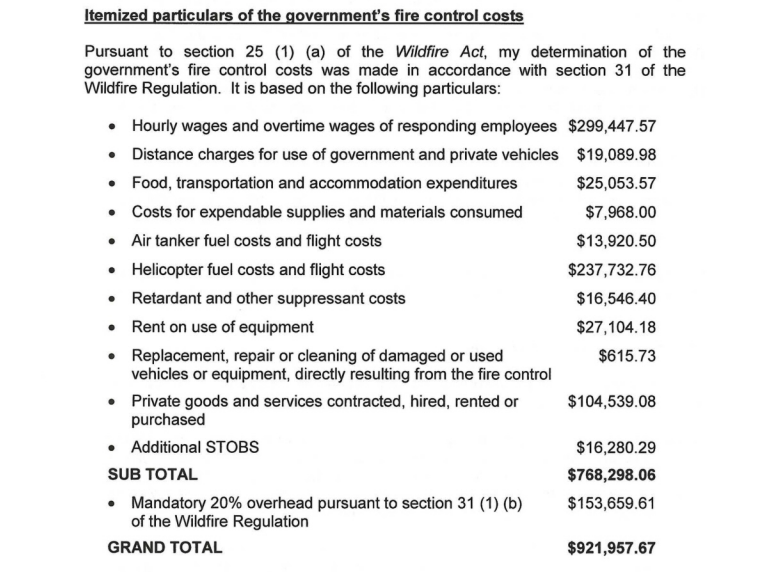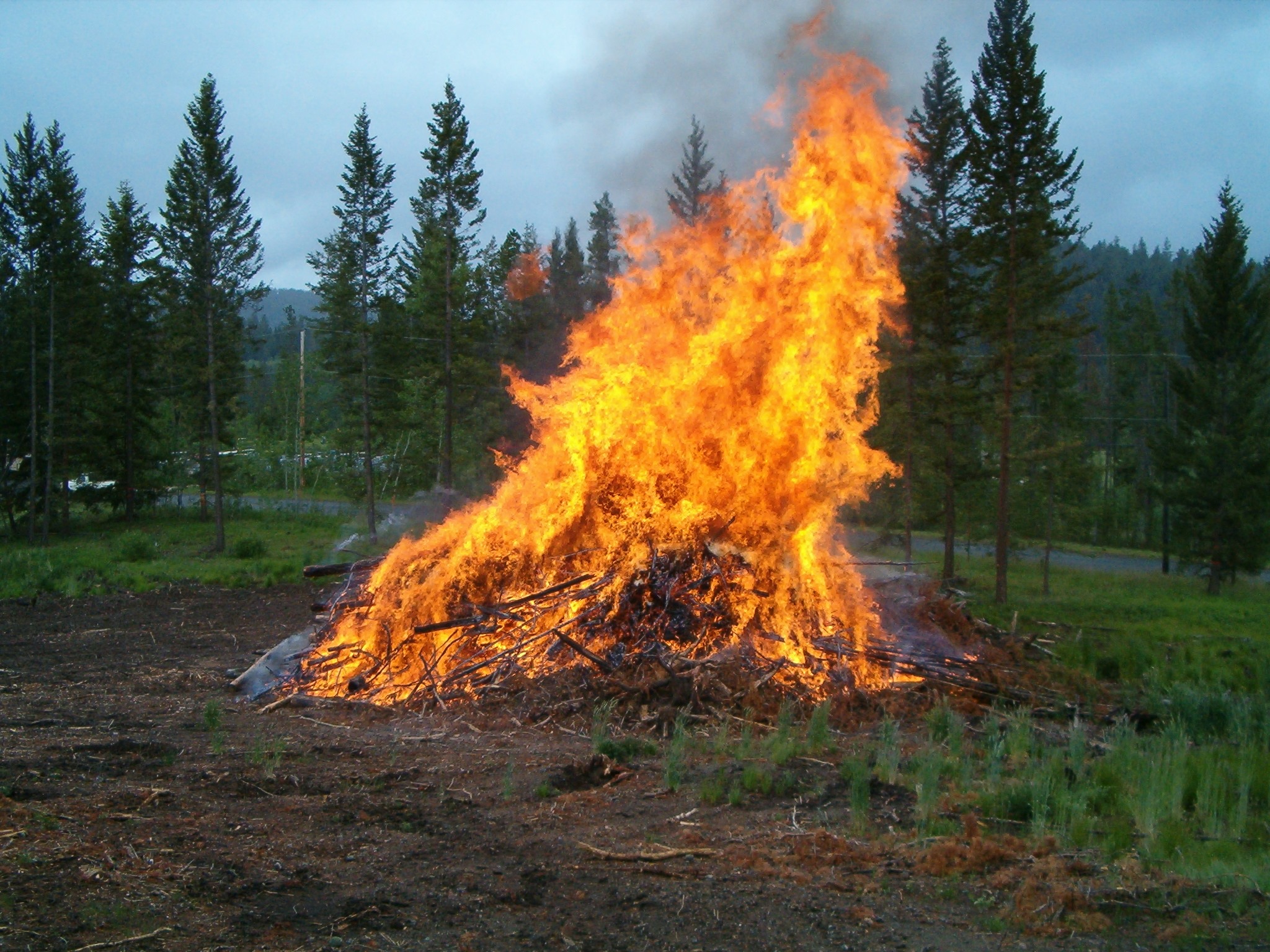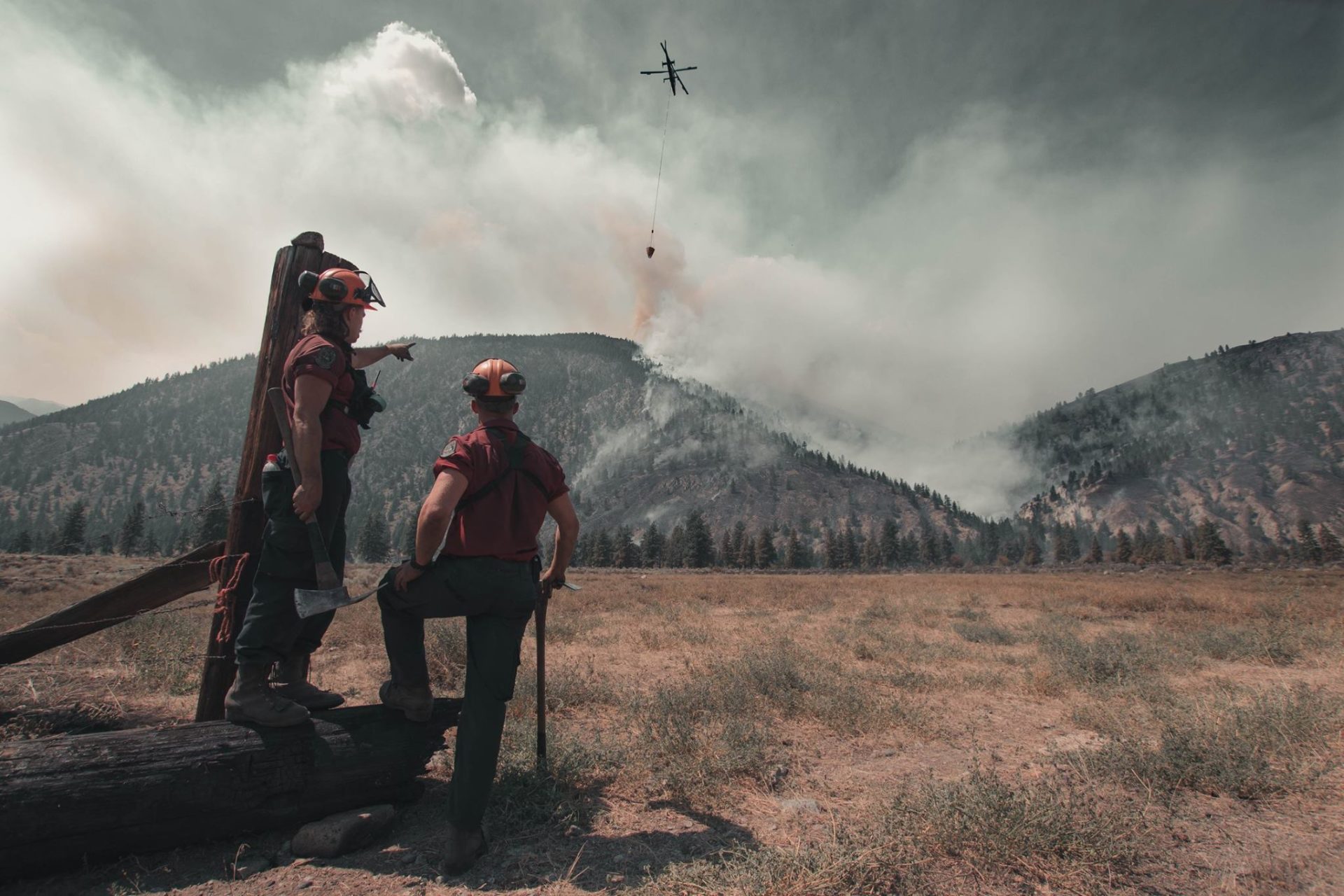
Court halts mine expansion as First Nation challenges B.C.’s decision to greenlight it
Court sides with Xatśūll First Nation, temporarily halting Mount Polley mine waste expansion
On April 7, 2012, Brian Cecil Parke ignited an enormous burn pile on his property near Pavilion Lake, west of Cache Creek, B.C.
The fire burned for two days before he left his property without extinguishing it.
The fire spread 140 hectares over the next 36 days before a call came into the RCMP, which notified the Kamloops Fire Centre of the blaze.
Parke’s actions landed him in front of a secretive, quasi-judicial body under the Ministry of Forests, Lands and Natural Resource Operations that, in 2017, ordered him to pony up almost $1 million in provincial firefighting costs, according to freedom of information documents obtained by The Narwhal.
The documents shed light on the little-known work of the ministry to track down firestarters and hold them accountable for their role in creating costly wildfires, which have become increasingly ferocious in recent years due to climate change.
The provincial Wildfire Act allows the B.C. government to recover “fire control costs and related amounts” from those who start wildfires. Those considered responsible have the right to an “opportunity-to-be-heard” proceeding before a “delegated decision maker” in a secretive process known to few outside the system.
The details surrounding the Ministry of Forest’s investigations and resulting wildfire penalties are not made public.
It’s not just individuals who are being held financially responsible — corporations have received the lion’s share of firefighting bills, with one penalty totalling more than $16 million.
And while seeking compensation for damages may be fair and good, some are raising concerns about the need for greater transparency around the penalties and who, ultimately, is responsible for handing them out.
Parke’s hearing found he ignited a Category 3 fire — defined as larger than two metres high by three metres wide — and left his property while it was still smouldering.
According to regulations outlined in the Wildfire Act, a fire of that size requires a fuel break (a gap in vegetation to slow a fire), someone monitoring it to ensure it doesn’t spread beyond its intended size and an official burn registration number with the province.
Parke did not meet any of these requirements.
Crews fought the resulting blaze for more than a month until June 16, although it wasn’t officially declared extinguished until Sept. 1.
For his role in the blaze, Parke was eventually handed a penalty of $921,958.
The government’s itemized claim against Parke included $299,448 for wages and overtime, and $237,733 for helicopters. The smallest amount, $616, was to cover the repair and replacement of equipment. A mandatory overhead fee of 20 per cent of expenses was included in the total.

An itemized list of wildfire fighting expenses charged to Parke under the Wildfire Act. These details were released to The Narwhal through a freedom of information request.
In early 2019, the Forest Appeals Commission, an independent body that allows alleged firestarters to dispute decisions, permitted Parke to appeal the fine. He successfully negotiated an agreement with the province to reduce the amount by close to half, down to $500,162.
During his opportunity-to-be-heard hearing, he complained that it took the province 3.5 years to notify him of its intention to recover costs, raising issues of procedural fairness. He also theorized that trespassers lighting a campfire or arsonists may have been to blame for starting the wildfire.
The documents note an investigation found Parke had a loader tractor, buckets, a hose, pumps and hand tools on site, but “no efforts were made to suppress the fire.”
Parke’s fine is on the higher side, but the general circumstances that led to his financial penalty are by no means unique.
The documents reveal that other cases involve private landowners like Parke who got careless burning debris piles or waste in a metal barrel.
In one case, campfires at a multi-day rave on private property attended by around 50 people got out of control, growing to 1.7 hectares. Provincial staff from the Clearwater and Kamloops fire zones attended the scene, and the unnamed owner of the property and party organizer was ordered in 2017 to pay $12,463 to cover firefighting costs.
Other cases involve major companies, deemed responsible for causing fires from train sparks, flaring at oil and gas operations or shoddy wiring at an outdoor work area.
But just who decides if people and companies are responsible — and how?
Under B.C.’s Wildfire Act and wildfire regulations, the fines associated with causing and failing to extinguish a fire are clearly laid out.
The province touts some of the highest fines in Canada.
And yet the process through which cost recovery for fighting wildfires is handled remains comparatively opaque.
Delegated decision makers run hearings where the accused have a chance to defend themselves. These decision makers, who tend to be regional forest centre managers or deputy managers, act like judges, determining responsibility and the firefighting costs to be recovered.
The fact that these individuals generally come from forestry, rather than legal, backgrounds isn’t necessarily a bad thing, according to Kevin Kriese, chair of the Forest Practices Board.
“The whole idea was not to plug up the courts,” Kriese told The Narwhal. These decision makers receive special training and have access to legal advice to help guide them in the process.
“If you look at fairness and access to justice, it’s a pretty efficient process,” Kriese said, adding the hearings tend to involve a mixture “of law and facts” and “a matter of some professional opinion” as to whether or not there was harm and its significance.
“It’s not a bad idea to have an actual professional or someone with knowledge of the topic making those decisions.”
In a written statement, the Ministry of Forests told The Narwhal an opportunity-to-be-heard hearing is not meant to resemble a civil court process. Rather, the hearing is “an informal fluid process” without pretrial discoveries or pretrial applications.
Kriese said he would welcome greater openness around the process because the prospect of bad publicity could result in fewer wildfires caused by negligence.
“If a company knows that someone else got fined $25,000 for doing X, that may have deterrent value,” he said. “Companies don’t like these on their books.”

As of April 16 “most open burning activities have been prohibited throughout British Columbia,” according to the BC Wildfire Service. Photo: BC Wildfire Service / Facebook
Vancouver lawyer Steven Wallace, who represented Parke, said there may be a perception that the hearings are biased since they are run by a provincial official seeking to recoup firefighting costs for their own ministry.
Even so, he said, the Forest Appeals Commission, where individuals and companies can fight against fines, is a separate and independent body.
Further appeals to decisions made by the Forest Practices Board can be brought to the B.C. Supreme Court.
The Forest Practices Board recommended in 2014 that the province create a publicly available, searchable database of penalties that have been handed out by the Ministry of Forests, including those under the Wildfire Act, to increase transparency. Currently, fines are only made public if they’re challenged at the Forest Appeals Commission.
But the province has been slow to act.
In its statement, the Ministry of Forests said the recommendation is being considered in light of legislative reform to the Forest and Range Practices Act “to enhance transparency and the public trust.”
(In light of this opportunity for reform, the Forest Practices Board reissued an appeal in 2019 for greater public disclosure.)
Parke had insurance to cover his bill, but that’s not always the case for landowners, putting them at serious financial risk.
“Frankly, some [fines] are going to bankrupt people,” Kriese said.
And not all appeals are as successful as Parke’s.
In 2017, the Forest Appeals Commission rejected Madeline Oker’s appeal of an order to pay $113,777 in firefighting costs and a $600 administrative penalty after her debris piles torched 8.7 hectares of Crown land near Fort St. John.
The commission said in its decision that “although Ms. Oker was experiencing financial hardship and may be unable to pay those costs, the legislation does not recognize an inability to pay as a basis for not ordering a person to pay for fire suppression costs.”
The overriding message from these hearings is that anyone conducting burns in or around a forest must appreciate the serious financial consequences should that fire get out of control, Wallace said.
“Anybody who is a major landowner with forests or who is working out in the forests must be very mindful of the requirements when dealing with fire.”
The freedom of information documents show corporate firestarters are by far the worst — and most stiffly penalized — offenders.
On the morning of June 11, 2015, CN workers cutting a rail line on the tracks near Lytton in the Fraser Canyon sent sparks into nearby grass. The fire danger rating that day was extreme, and rail-cutting is considered a high-risk activity.
Fuelled by dry conditions, strong winds and steep terrain that hampered firefighting efforts, the so-called Cisco Road fire grew stronger. It eventually ravaged 2,200 hectares of Crown land — more than five times the size of Stanley Park — and prompted an evacuation order for the Lytton First Nation.
The blaze wasn’t considered fully extinguished until October but continued to smolder for years — ending with a very pricey outcome for CN.
In May 2018, CN was ordered to pay the province a whopping $16.28 million in cost-recovery fees and penalties for the fire.
CN disputed the amount to the Forest Appeals Commission, which actually increased the amount on March 20, 2020, to $16.61 million due to new information presented on the extent of wildfire damage.
The upgraded penalty included $169,065 for silviculture and reforestation, a $75,000 administrative penalty, $52,189 for loss of Crown timber, $9.37 million for other forest and grassland resources and $6.94 million for firefighting costs.
CN did not provide The Narwhal with a response.
The penalty against the railway may be the biggest of its kind in B.C.

Fighting forest fires takes a ton of time, resources and money. If you start a blaze in B.C., you could be on the hook for hundreds of thousands — even million — of dollars. Photo: B.C. Wildfire Service
“It’s certainly the largest one I’ve seen,” said Vancouver lawyer Ryan Morasiewicz, who specializes in law related to outdoor adventure. “People have to take these things seriously. I don’t think people realize, holy shit, if you’re negligent, you can be on the hook for a lot of money.”
In 2013, Telus was found responsible for a tree falling on a power line along a forestry service road in 2006, which created a 380-hectare fire. The company was forced to pay in excess of $2.1 million for fire-control costs and the loss of Crown timber.
The documents also show CN’s problems were not isolated to the Cisco Road fire. The company received a penalty of $321,929 after one of the company’s trains ignited a wildfire that burned 171 hectares of winter habitat for mule deer and an old-growth management area near Williams Lake in 2014.
Forty-four per cent of that fine was for mature Crown timber damaged or destroyed by the fire. The rest was to cover other affected forests and grasslands.
The Forest Appeals Commission reduced the company’s penalty to $203,597 in 2017.
CN was also ordered to pay $142,974 in 2017 for three wildfires within a span of about two months near Spences Bridge, Chetwynd and Hansard — a railway point northwest of the junction of the Fraser River and Bowron River.
The company paid an additional $199,727 in 2019 for six fires — near Houston, Burns Lake, Kumsheen, Boston Bar and two near Lytton.
CP has also had its troubles. In 2019, the company was ordered to pay $155,247 for two fires, about two months apart, north of Spences Bridge and south of Lytton, the latter caused by rail-cutting.
British Columbia stands to face an ever-growing threat from wildfires due to global warming.
The last decade was the hottest on record. Warmer temperatures mean drier forests, more dead trees from drought and beetle infestation and more frequent lightning strikes. These conditions are causing bigger wildfires that burn hotter and faster.
The province got off relatively lucky in 2019, when 21,138 hectares burned at a firefighting cost of $182.5 million.
That came as a relief after two back-to-back record-breaking wildfire seasons. In 2017, 1.21 million hectares at cost of $649 million and in 2018 an estimated 1.35 million hectares burned at a cost of $615 million.
In those two years, humans caused 41 per cent and 25 per cent of the fires, respectively.
Fighting climate change is a tough uphill battle. Taking personal and corporate responsibility for ensuring fires do not get out of control is well within our reach.
Get the inside scoop on The Narwhal’s environment and climate reporting by signing up for our free newsletter. On a warm September evening nearly 15...
Continue reading
Court sides with Xatśūll First Nation, temporarily halting Mount Polley mine waste expansion

Break out the champagne: Emma’s storied life and leadership in journalism has earned her the...

How can we limit damage from disasters like the 2024 Toronto floods? In this explainer...
